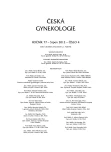Review of current classification and terminology of vulvar disorders
Authors:
J. Sláma
Authors‘ workplace:
Onkogynekologické centrum, Gynekologicko-porodnická klinika VFN a 1. LF UK, Praha, přednosta prof. MUDr. A. Martan, DrSc.
Published in:
Ceska Gynekol 2012; 77(4): 287-292
Overview
Objective:
To summarize current terminology and classification of vulvar disorders.
Design:
Review article.
Setting:
Gynecologic oncology center, Department of Gynecology and Obstetrics, General Faculty Hospital and 1st Medical School of Charles University, Prague.
Methods and results:
Vulvar disorders include wide spectrum of different diagnoses. Multidisciplinary collaboration is frequently needed in diagnostical and therapeutical process. It is essential to use unified terminology using standard dermatological terms, and unified classification for comprehensible communication between different medical professions. Current classification, which is based on Clinical-pathological criteria, was established by International Society for the Study of Vulvovaginal Disease. Recently, there was introduced Clinical classification, which groups disorders according to main morphological finding.
Conclusions:
Adequate and unified classification and terminology are necessary for effective communication during the diagnostical process.
Key words:
vulvar disorder, VIN, vulvar dermatosis, classification, terminology.
Sources
1. Haefner, HK, Collins, ME, Davis, GD, et al. The vulvodynia guideline. J Lower Gen Tract Dis, 2005, 9(1), p. 40–51.
2. Haefner, HK. Report of the International Society for the Study of Vulvovaginal Disease. Terminology and Classification of Vulvodynia. J Low Gen Tract Dis, 2007, 11(1), p. 48–49.
3. Hart, WR. Vulvar intraepithelial neoplasia: historical aspects and current status. Int J Gynecol Pathol, 2001, 20, p. 16–30.
4. http://www.issvd.org/document_library/BibliographyTermino logy2012CORRECTED.pdf
5. Lunch, PJ., Moyal-Barrocco, M., Bogliatto, F., et al. 2006 ISSVD classification of vulvar dermatoses: pathologic subsets and their clinical correlates. J Reprod Med, 2007, 52(1), p. 3–9.
6. Moyal-Barracco, M., Lunch, PJ. 2003 ISSVD terminology and classification of vulvodynia: a historical perspective. J Reprod Med, 2004, 49(10), p. 772–777.
7. Preti, M., Mezzetti, M., Robertson, C., Siderit, M. Inter-observer variation in histopathological diagnosis and grading of vulvar intraepithelial neoplasia: results of an European collaborative study. BJOG, 2000, 107(5), p. 594–549.
8. Siderit, M., Jones, RW., Wilkinson, EJ., et al. Squamous vulvar intraepithelial neoplasia: 2004 Modified Terminology, ISSVD Vulvar Oncology Subcommittee. J Reprod Med, 2005, 50, p. 807–810.
9. Štork, J. Dermatovenerologie. Praha: Galén, 2008, 502 s.
10. Yang, B., Hart, WR. Vulvar intraepithelial neoplasia of the simplex (differentiated) type: a clinicopathologic study including analysis of HPV and p53 expression. Am J Surg Pathol, 2000, 24(3), p. 429–441.
Labels
Paediatric gynaecology Gynaecology and obstetrics Reproduction medicineArticle was published in
Czech Gynaecology

2012 Issue 4
Most read in this issue
- Endometriosis
- Vaginal prolapse and levator ani avulsion injury
- The rational preoperative diagnosis of ovarian tumors – imaging techniques and tumor biomarkers (review)
- Ultrasound in urogynecology
